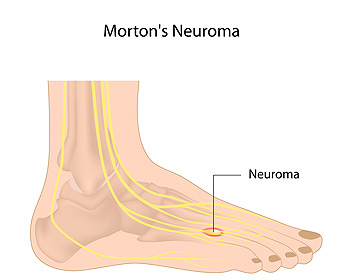Diagnosing Morton's Neuroma
Monday, 01 March 2021 00:00 Morton’s neuroma is a condition in which the nerve tissue between the toes thickens, causing pain. The most common location for a Morton’s neuroma is the area between the third and fourth toes. Besides being painful, Morton’s neuroma can also cause tingling, burning, and cramping in the toes that worsens over time. Left untreated, the affected nerve may become permanently damaged. A podiatrist can diagnose Morton’s neuroma by examining the foot. Your doctor may squeeze the front of the foot or toes together to see if this produces symptoms. Imaging studies, such as an MRI or an ultrasound, may be ordered to confirm the diagnosis. X-rays, electromyography, and blood tests may also be recommended to rule out other conditions with similar symptoms. If you suspect that you may be suffering from Morton's neuroma, it is suggested that you seek the care of a podiatrist.
Morton’s neuroma is a condition in which the nerve tissue between the toes thickens, causing pain. The most common location for a Morton’s neuroma is the area between the third and fourth toes. Besides being painful, Morton’s neuroma can also cause tingling, burning, and cramping in the toes that worsens over time. Left untreated, the affected nerve may become permanently damaged. A podiatrist can diagnose Morton’s neuroma by examining the foot. Your doctor may squeeze the front of the foot or toes together to see if this produces symptoms. Imaging studies, such as an MRI or an ultrasound, may be ordered to confirm the diagnosis. X-rays, electromyography, and blood tests may also be recommended to rule out other conditions with similar symptoms. If you suspect that you may be suffering from Morton's neuroma, it is suggested that you seek the care of a podiatrist.
Morton’s neuroma is a very uncomfortable condition to live with. If you think you have Morton’s neuroma, contact Dr. Steven Schwartz of Pennsylvania. Our doctor will attend to all of your foot care needs and answer any of your related questions.
Morton’s Neuroma
Morton's neuroma is a painful foot condition that commonly affects the areas between the second and third or third and fourth toe, although other areas of the foot are also susceptible. Morton’s neuroma is caused by an inflamed nerve in the foot that is being squeezed and aggravated by surrounding bones.
What Increases the Chances of Having Morton’s Neuroma?
- Ill-fitting high heels or shoes that add pressure to the toe or foot
- Jogging, running or any sport that involves constant impact to the foot
- Flat feet, bunions, and any other foot deformities
Morton’s neuroma is a very treatable condition. Orthotics and shoe inserts can often be used to alleviate the pain on the forefront of the feet. In more severe cases, corticosteroids can also be prescribed. In order to figure out the best treatment for your neuroma, it’s recommended to seek the care of a podiatrist who can diagnose your condition and provide different treatment options.
If you have any questions, please feel free to contact our offices located in Chambersburg, and Mcconnellsburg, PA . We offer the newest diagnostic and treatment technologies for all your foot care needs.

